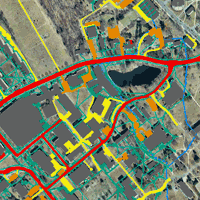
Background on IC-TMDLs (see also video on home page)
Urban Stream Syndrome & Traditional Water Regulation
In the developed and developing landscapes of Connecticut, many watersheds suffer from what is often known as “urban stream syndrome,” degradation of our water resources that results from a complex combination of factors related to urbanization. The individual roles of each of these factors are extremely difficult to determine, making traditional regulatory approaches challenging to implement. Consequently, in the future Clean Water Act programs like the National Pollutant Discharge Elimination System (NPDES) Stormwater permitting program (also known as the “Stormwater Phase II” or “MS-4” program) and the Total Maximum Daily Load (TMDL) program are likely to expand their use of surrogate indicators as a way to quantitatively address urban stream syndrome.
Surrogate Indicators
Surrogate indicators are measurable waterway or landscape characteristics that scientific research has shown to be closely correlated with water quality or watershed health. Impervious surfaces, or the impenetrable hard surfaces associated with development (roads, rooftops, parking areas, etc.), are just such a surrogate indicator. Together, these impervious surfaces are often known as impervious land cover, or impervious cover (IC) for short. Since the close relationship of IC to watershed health is well documented in the scientific literature, many expect to see an increase in the number of towns subjected to an impervious cover-based TMDL or other regulation.
So what’s an Impervious Cover-based TMDL really mean?
The main reason why IC is so closely related to water pollution is that the hard parts of our landscape provide an expressway for runoff-borne pollutants into our waterways. So, an “IC-TMDL” is meant to focus attention not just on impervious cover, but on the direct connection between paved surfaces and waterways. While actually reducing the amount of IC is desirable, the primary focus of an IC-TMDL is on devising ways to short-circuit, or disconnect, the pavement-to-waterway connection. This is primarily accomplished through the use of what are often referred to as low impact development (LID), or green infrastructure (GI) practices.


